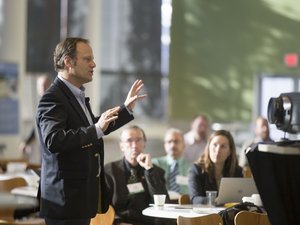Master study courses
Enterprise Modelling II: Lecture (Concepts and Theories)

This lecture extends the knowledge gained in Enterprise Modelling I. First, the participants will learn to assess and use advanced concepts of object-oriented modelling. The engineering approach to developing software will be considered, then contrasted with alternative approaches, such as agile methods and the Soft Systems Methodology. Further chapters are dedicated to advanced business process modelling and approaches available to assess the quality of conceptual models.
Domain-specific modelling languages (DSML) lie at the heart of conceptual modelling. The participants will learn to judge the specific benefits and challenges related to DSML as opposed to general-purpose modelling languages such as the UML. A presentation of the core concepts and their specification through meta-models is supplemented by application scenarios – including model-driven software development.
Methods for enterprise modelling, which generally make use of DSML, are at the core of the lecture. An overview of important methods will give an idea of objectives and key abstractions. Against this background, the MEMO (Multi-Perspective Enterprise Modelling) method is taught in more detail, and its utility illustrated through various application scenarios. To enable a deeper understanding of MEMO, its conceptual foundation will be outlined including the language architecture and excerpts of meta-models. The goal is to lead participants to an understanding that enterprise modelling offers a versatile conceptual foundation for method engineering. In addition, we will examine the architecture of the relevant modelling tool, MEMO Center NG,. Our hope is that our students will emerge not only understanding the concepts of reference enterprise models, but appreciate the remarkable effort it takes to develop enterprise models, and the set of challenges related to their construction and dissemination.
It is recommended that participants attend the accompanying tutorial (Enterprise Modelling II: Applying Methods and Tools).
Enterprise Modelling II: Tutorial (Applying Methods and Tools)
In this advanced course on enterprise modelling, students learn how to deal with modelling challenges in three areas, business process modelling, object-oriented modelling, and meta modelling. As an integral part of the module, Enterprise Modelling II, the course applies the theoretical considerations on enterprise modelling (taught in the corresponding lecture) to hands-on modelling tasks. Students engage in modelling exercises, discuss their proposed solutions with each other and develop the advanced modelling competences essential to Wirtschaftsinformatik graduates. The course is based on class discussions, student presentations, modelling exercises, and literature research work undertaken outside of class. Successful completion of the course will prepare students to design, present, analyze, and evaluate advanced process models, object-oriented models and meta-models as well as partial enterprise models. Knowledge of software development methods from the lecture will be enhanced and their respective strengths and weaknesses through the introduction of application examples identified. As a result, a student should be able to decide whether or not the application of a method is appropriate given the requirements of a specific context.
IBIS I: Lecture (Concepts and Theories)

Designing and implementing corporate information systems are pivotal topics of Wirtschaftsinformatik. While the modules Enterprise Modelling 1 and Enterprise Modelling II mainly focus on analysis and conceptual design, this lecture emphasizes a bottom-up perspective on implementation level artefacts, such as applications, technologies and standards. Methods and technologies to develop integration systems as well as to foster the integration of existing systems are at the core of the lecture.
The lecture starts by motivating the need for integration and reusability. Since integration is a vastly overloaded term, the students will be provided with a concept of integration that accounts for the peculiarities of information systems and can be applied to organizational integration – IT business alignment – as well. To further illustrate the need for integration in current IT landscapes, the participants will get an overview of functions covered by traditional business applications such as systems for accounting, human resource management, or production planning. Against this background, key approaches to promote the integration of corporate information systems will be presented and evaluated. This will include data exchange formats for loosely coupled systems and corresponding standards, database technologies as well as persistency in general. These approaches will be discussed and evaluated from both software-engineering and managerial perspectives. The presentation of decision support systems will provide further insights into the need for integrated information systems. For this purpose, their conceptual foundation and the need to integrate them with operational level systems will be analysed.
Having gained an appropriate understanding of the concepts and technologies presented in the lecture, students are given the opportunity to practice their use in the accompanying tutorial.
IBIS I: Tutorial (Applying Methods and Tools)
While the lecture primarily covers fundamental questions and challenges related to the design of integrated systems (ex-ante) as well as the integration of existing systems (ex-post), the tutorial focuses corresponding technologies and standards. Thereby, the tutorial extends and deepens the contents presented in the lecture.
For this purpose, the tutorial will start with XML and related technologies (e.g., XML Schema, XQuery, XPath, XSLT, XML standards, Java + XML) to allow for the integration of business information systems based on document exchange format. Subsequently, integration through data base technologies will be covered. This will include topics such as relational databases, data warehouses, object persistency, and non-standard databases. The tutorial will conclude with data mining and selected examples for decision support systems.
IBIS II: Lecture (Concepts and Theories)

This lecture continues from where the lecture Integration of Business Information Systems I left off. The lecture starts with the discussion of advanced requirements for integrating corporate information systems. It is supplemented by idealized models of the evolution of system architectures. Against this background, a reference model for the description and evaluation of what is called middleware will be presented. It serves as a framework for describing and discussing selected middleware systems, such as CORBA and J2EE.
In recent years, component technologies have attracted a remarkable amount of attention. However, to date there is no unified terminology. The lecture presents a notion of a component, which allows it to be discriminated from the notion of an object or a class. Web Services are regarded by some as a silver bullet for establishing process-oriented information systems – usually in conjunction with workflow management systems. This claim will be analysed in detail. Subsequently, objectives, technologies and methods for integrating existing application infrastructures will be presented and evaluated. This includes taking into account approaches to Enterprise Application Integration. Finally, the lecture will demonstrate how complexity and risk related to integration projects can be reduced by a dedicated modelling method. It is recommended that participants attend the accompanying tutorial.
IBIS II: Tutorial (Applying Methods and Tools)
The tutorial extends and deepens the contents presented in the lecture. Functions provided by middleware solutions such as CORBA will be used to realize small distributed applications. This will allow assessing the advantages and disadvantages of corresponding integration strategies. Service-oriented Architectures (SOA) and Web Services are widely regarded as a key technology for implementing process-oriented information systems. This tutorial will investigate this claim in detail by closely looking at concrete technologies and available tools for SOA. Popular standards for realizing loose coupling and implementing workflow-based service orchestration will be presented and evaluated. This will include the Web Service interface Definition Language (WSDL) and the Business Process Execution Language (WS-BPEL). Based on this technological foundation, workflow management systems for the support of dynamic integration in the context of business processes will be covered.
Advanced Topics in Information Systems I

Advanced Topics in Information Systems 1 (ATIS1) is designed to be the first encounter with Information Systems (IS) research literature. The scientific discipline of IS deals with technical as well as behavioural issues surrounding the development, use, management, and impact of computer-based information systems, i.e. socio-technical systems comprising technology, organisations, and people. It is the English-speaking world's counterpart to "Wirtschaftsinformatik".
This research-focused unit introduces core research strategies and methods employed in IS research and demonstrates their use in selected IS research contributions. The course aims at developing the ability to critically read, think about, analyze, interpret, and evaluate research literature. It has the character of both an initial introductory lecture and a subsequent research seminar.
ATIS1 is designed as a highly interactive course with students preparing, presenting, and discussing readings earlier assigned in class. In each session a research method will be addressed through a critical discussion of one or more journal papers. The discussion will be led by a class member. For each session, students are required to prepare the assigned readings and submit a write-up, typically after reading one or more book chapters and a journal paper and by answering questions in writing.
On completion of this unit, students will:
- understand selected research approaches, strategies and methods (e.g. design research, survey, experiments)
- be aware of underlying issues in the philosophy of science
- be able to read critically, think about, and analyze an IS journal paper and, to a certain extent, interpret and evaluate research contributions
- have knowledge of selected issues in IS research not covered elsewhere in the curriculum (and be aware of key outlets for IS research such as journals, conferences, and workshops)
The course is based on the proposition that active participation enhances the learning experience. This pedagogical approach requires all students to commit to in-depth preparation before classes and to making active contributions during them.
All students should be prepared to contribute to all class discussions, in particular by:
- applying concepts introduced by the reading materials
- integrating colleagues' comments
- proposing and justifying a contradictory opinion
- comparing previously discussed case studies
- asking pertinent questions
- sharing personal experiences relevant to the discussions.
In addition, all students will be required to give a presentation on a research paper, of 30 minutes duration, in English. Students will also be expected to discuss findings arising from the task with fellow students.
Course language
The course language is English.
Assessment
Assessment will be based on a final written exam (in English).
Course schedule
This course has a biweekly rhythm with 3 hours sessions.
Course certificate
Successful participants will receive a written attestation stating their completion of the requirements of an English-based course.
Textbook
Oates, Briony: Researching Information Systems and Computing, Sage, London, UK, 2006 (UB: E30 TTI1132+1 and E33 TTI1132+1, +2, +3, +4, +5).
Prerequisites
Students should have successfully completed a term paper (Seminararbeit) and at least one module from the "Enterprise Modelling" or "Integration of Business Information Systems" tracks (see Curriculum). Subsequent attendance of "Advanced Topics in Information Systems 2" (ATIS2) is recommended but not required. However, in order to qualify for 6 ECTS for the Compulsory Modules 1 part of the Master's programme, successful completion of both modules (ATIS1 and ATIS2) is mandatory.
Target audience
This course is designed for students in their final year and ideal for those students intending to write a research-oriented M.Sc. thesis.
Advanced Topics in Information Systems II
Advanced Topics in Information Systems 2 (ATIS2) is designed as an in-depth examination of a selected topic in Information Systems (IS) research literature. The IS discipline is the English-speaking world's counterpart to "Wirtschaftsinformatik".
This unit focuses on a selected topic, e.g., governance and management of IT, IS/IT alignment, effective development of IS, and delivery of business benefits through IT. It uses IS research literature to consider the topic from different perspectives, i.e., to address critical debates and issues. The topic covered may vary from offering to offering.
Each session a topic will be addressed through a critical discussion of one or more journal papers. Each discussion will be led by a class member.
At the completion of this unit students will:
- have knowledge of key issues and controversies of IS research and practice,
- be able to contribute to a structured discussion of key IS issues,
- be able to critically read, think about, and analyze an IS contribution and, to a certain extent, interpret and evaluate research contributions,
The course is based upon the proposition that active participation enhances the learning experience. This pedagogical approach requires an in-depth preparation of the readings before class and an active contribution from all the students during class.
All students must contribute to all class discussions, notably by:
- applying concepts introduced in the readings
- integrating colleagues' comments
- proposing and justifying a contradictory opinion
- comparing previously discussed case studies
- asking pertinent questions
- sharing personal experiences relevant to the discussions.
Course language
The course language is English.
Assessment
Assessment will be based on a final written exam (in English).
Course schedule
This course has a biweekly rhythm with 3 hours sessions.
Course certificate
Successful participants will receive a written attestation stating their completion of the requirements of an English-based course.
Prerequisites
Students should have successfully completed at least one module from the "Conceptual Modelling" or "Integration: Concepts, Technologies and Standards" tracks, i.e., modules 3.10, 3.11, or 3.12 (see Curriculum). Prior knowledge of "Advanced Topics in Information Systems I" (ATIS I) is recommended but not required.
Target audience
This course is designed for students in their final year and ideal for those students intending to write a research-oriented M.Sc. thesis.
Seminar

As a default, a seminar is a forum for discussing current topics of ‘Wirtschaftsinformatik’. Usually, these topics will belong to one common generic topic. Every participant has to write a seminar paper on a topic he was assigned to. Subsequently, he has to present the paper and encourage its discussion. The seminar is aimed at three interwoven objectives. The seminar paper serves to practice scientific writing. Presenting it fosters the development of presentation skills, which include the proper use of presentation software. The collective discussion of the papers contributes to the development of a sophisticated perspective on the overall generic topic. At the same time it promotes the participants discoursive competence. As an exception, a seminar can be organized in a different manner, e. g. by putting more emphasis on team work.
Announcements of these topics and corresponding deadlines are presented on the WISEM-Webseite.
Master project

In the Master project, participants handle one large task over the period of a whole semester. This is carried out with close focus on practical applications, by which theoretical knowledge that has been gained before is trained in joint project work.
The Master project is worth 12 ECTS per project participant. Suggested topics are usually published shortly after the start of the semester.
Theses

For writing a thesis at our chair, you find further information in "Theses"
